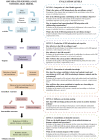Evaluating the Integration of One Health in Surveillance Systems for Antimicrobial Use and Resistance: A Conceptual Framework
- PMID: 33842569
- PMCID: PMC8024545
- DOI: 10.3389/fvets.2021.611931
Evaluating the Integration of One Health in Surveillance Systems for Antimicrobial Use and Resistance: A Conceptual Framework
Abstract
It is now widely acknowledged that surveillance of antimicrobial resistance (AMR) must adopt a "One Health" (OH) approach to successfully address the significant threats this global public health issue poses to humans, animals, and the environment. While many protocols exist for the evaluation of surveillance, the specific aspect of the integration of a OH approach into surveillance systems for AMR and antimicrobial Use (AMU), suffers from a lack of common and accepted guidelines and metrics for its monitoring and evaluation functions. This article presents a conceptual framework to evaluate the integration of OH in surveillance systems for AMR and AMU, named the Integrated Surveillance System Evaluation framework (ISSE framework). The ISSE framework aims to assist stakeholders and researchers who design an overall evaluation plan to select the relevant evaluation questions and tools. The framework was developed in partnership with the Canadian Integrated Program for Antimicrobial Resistance Surveillance (CIPARS). It consists of five evaluation components, which consider the capacity of the system to: [1] integrate a OH approach, [2] produce OH information and expertise, [3] generate actionable knowledge, [4] influence decision-making, and [5] positively impact outcomes. For each component, a set of evaluation questions is defined, and links to other available evaluation tools are shown. The ISSE framework helps evaluators to systematically assess the different OH aspects of a surveillance system, to gain comprehensive information on the performance and value of these integrated efforts, and to use the evaluation results to refine and improve the surveillance of AMR and AMU globally.
Keywords: One Health; antimicrobial resistance; evaluation; framework; integrated surveillance; methodology; surveillance.
Copyright © 2021 Aenishaenslin, Häsler, Ravel, Parmley, Mediouni, Bennani, Stärk and Buckeridge.
Conflict of interest statement
The authors declare that the research was conducted in the absence of any commercial or financial relationships that could be construed as a potential conflict of interest.
Figures


Comment in
-
Evaluating the OH-EpiCap tool using the Danish integrated surveillance program for AMU and AMR as a case study.Front Public Health. 2023 Nov 20;11:1127701. doi: 10.3389/fpubh.2023.1127701. eCollection 2023. Front Public Health. 2023. PMID: 38054067 Free PMC article.
References
-
- Interagency Coordination Group on Antimicrobial Resistance . No Time to Wait: Securing the Future From Drug-Resistant Infections. World Health Organization. (2019). Available online at: http://www.who.int/antimicrobial-resistance/interagency-coordination-gro... (accessed June 25, 2020).
-
- Tang KL, Caffrey NP, Nóbrega DB, Cork SC, Ronksley PE, Barkema HW, et al. . Restricting the use of antibiotics in food-producing animals and its associations with antibiotic resistance in food-producing animals and human beings: a systematic review and meta-analysis. Lancet Planet Health. (2017) 1:e316–27. 10.1016/S2542-5196(17)30141-9 - DOI - PMC - PubMed
Grants and funding
LinkOut - more resources
Full Text Sources
Other Literature Sources

